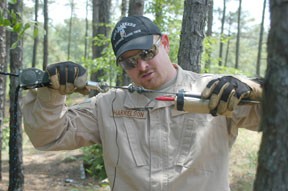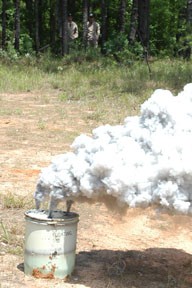Editor's note: This is the second in a series of stories about the Joint Readiness Training Center. This series explores the people and organizations behind the scenes of a unit rotation at the center. The first story appeared in the May 7 issue of the "Guardian" and covered roleplayers.
FORT POLK, La. - A platoon of Soldiers rides down miles of gravel roads - tense, alert, watching. At any minute they may be attacked with improvised explosive devices, rocket propelled grenades or small arms fire. The 4th Brigade Combat Team, 101st Airborne Division, Fort Campbell, Ky., has encountered a great deal of enemy activity on these roads in the past few days. Without warning, an RPG slams into one of the convoy's HMWWVs. Chaos ensues, staunched only by the Soldiers' cool heads and ingrained training. Smoke fills the battle space and the Soldiers return fire in the direction of their attackers. Once the disabled vehicle is hooked up for towing, the platoon continues on its way, one step closer to their imminent deployment.
The 4th BCT is on rotation at the Joint Readiness Training Center, preparing for a deployment to Afghanistan. The realism of their training depends on the pyrotechnic endeavors of an indispensable group of people at JRTC: The firemarkers.
Firemarkers fill several roles at JRTC, most of which involve creating a "signature" for events on the battlefield - explosions, threats for aviation assets, indirect fire (artillery and mortar) and smoke. The group, which numbers about 100, also is responsible for maintaining the training center's forward operating bases, caring for interpreters during rotations and assisting with live fire operations at the Peason Ridge training area.
James Rogers, branch chief for the firemarkers, has been part of the contract since JRTC relocated to Fort Polk in 1993. "It would be a lot quieter at JRTC without us," he said. "Any time we pop pyro it starts a snowball effect. The unit has to react, go through their battle drills, report what's happened to their higher headquarters and take care of casualties."
The group is never far from any place at the training center, which is often called "the box." At force-on-force, the culminating event for rotational training units, firemarkers are stationed all over JRTC. "We have a quick response time anywhere in the box," Rogers said. "Trainer/mentors can request support for the battlefield effects they want. We're flexible about where we can put our effects and can move them to accommodate the TMs."
The firemarkers have a legacy of adapting to the modern battlefield. As insurgents in Iraq and Afghanistan develop new tactics, they are replicated at JRTC, ensuring that the U.S. military deploys with the most up-to-date training possible. "In the early days of the Iraq war, RPGs were a big threat," said Rogers. "We didn't have anything to replicate an RPG signature, but we watched battlefield footage, brainstormed and developed the prototype for the wire-guided RPG that we have now. It started off as a piece of PVC pipe and a model rocket engine. We worked with the Safety Office and Operations Group to get a commercial vendor to produce a safe version. We replicate everything as well as we can without using actual military munitions."
Another development involved parachutes and pool toys. "We began to hear that units were being engaged with a Soviet-made grenade called the RKG3, which explodes on contact with a vehicle," Rogers said. "We watched a video of one being used and built a replica with items from a home improvement store. It has a parachute that slows its descent when it is thrown, and the body is constructed from a foam pool toy. We have guys dressed as (opposing forces) who throw the grenade at convoys and then set off pyro to simulate the explosion."
The firemarkers' most dramatic device is their vehicle-borne IED simulator. It is a pickup truck specially fitted for pyrotechnics, which can drive up to a target and detonate. The truck is reinforced with steel and poses no safety hazard to the driver or its target, but creates a loud and fiery explosion. "If the truck gets stopped, there are items in it that should tip off the rotational unit," said Rogers. The driver also presents the physical indicators of a suicide bomber. "The driver gets a natural adrenaline rush," Rogers explained. "It becomes obvious when a VBIED is about to be detonated. The VBIED may try to avoid check points, or drive toward a FOB, bypassing the main road."
When JRTC opposing forces place an IED on a road, they call the firemarkers to verify it. "We make sure they have all the components to emplace a realistic IED, and make sure it works," Rogers said. "Ops group then tracks each IED and what happens to it. OPFOR can have up to 12 active IEDs at any time. When an IED is active, a firemarker has to sit with it, too, and detonate it when the OPFOR gives a signal.
"There is a lot of cross-talk and coordination between the different elements at JRTC. There is a good flow of information. We work with roleplayers and JRTC video camera operators, because they are also on the battlefield. They know where they can be safe and not interfere with pyrotechnics."
The firemarkers receive rigorous training and safety is always their first consideration. Newly hired firemarkers get two weeks of instruction. One week is in the classroom, the second week is in the box. The course includes night vision device training, radio procedures, pyrotechnics, military rank structure and land navigation. An emphasis is placed on learning to navigate with a map and compass. "We have GPS devices, but they can break down," said Rogers.
The trainees also get hands-on classes on pyrotechnics and IEDs. "We have vehicles drive through their IED sites so they can get used to timing the detonations," Rogers said. Firemarkers also spend a lot of time riding all-terrain vehicles to event sites on the battlefield. The supervisors are certified ATV instructors and ensure the trainees learn safe riding practices.
A firemarker has to be a hardy individual, too. "We're out here in any condition, just like the Soldiers are," Rogers said. He has seen his share of unique training missions since he began working at JRTC. One event was held at the Alexandria airport, soon after the Air Force base there was closed in 1992. "We went up there and supported a special unit attack on the airfield," he said. "The OPFOR was there with some 'high value targets' they had 'kidnapped.' The unit came in, captured the airfield and rescued the hostages, while we provided indirect fire."
Despite the complexity of the job, there are equal rewards. "There's something new every day. It's rewarding to know that I'm helping Soldiers get trained," Rogers explained. "A lot of the firemarkers keep track of how many fire missions they mark in a day, and they make it a competition. You get a burst of adrenaline when you do a fire mission."
Grant Beason is a firemarker who serves as an FOB supervisor. He ensures that the buildings on his FOB are maintained, and oversees and dispatches interpreters to the RTU. "FOB supervisors are the go-between for the RTUs and the interpreters," he said. "We have a point of contact in the brigade who requests interpreters and I have them ready for the unit to pick up.
"We also deal with the RTU FOB mayor, who can request infrastructure improvements like barricades or wire. We coordinate with maintenance contractors for repairs and provisions." Beason works directly with RTUs and finds it stimulating. "Soldiers aren't always happy to be here, for obvious reasons, but I have heard from many of them that JRTC helped them," he said. "That makes my work worthwhile. I didn't realize there were so many different personalities in the Army until I got this job. Each unit that comes here is different, too. The 101st has been a 'blast' to work with."
The TMs and firemarkers at JRTC have a symbiotic relationship, which makes training realistic. "We've developed a friendship," said Sgt. 1st Class Jeff George, a TM with Ops Group. "The camaraderie that exists between us makes coming to work enjoyable. A lot of the firemarkers have military backgrounds, too, which helps them react and identify vehicles - we're all on the same page."
"We found out a couple of days ago how important to the mission it is to have the firemarkers out here," George said. "When conditions were dry and we couldn't ignite pyro, we were unable to simulate explosions, which serve as the initiators to engagements. Firemarkers are essential to training out here - they add realism. It's just not the same if I run out of the woods and yell 'boom!'
"RTUs can't get the same realism at their home station," George continued. "We get good feedback from the RTUs. I've never heard any negative comments about the firemarkers, and I don't have anything but praise for them."
Robbie Harrelson initiated the RPG attack on the 101st convoy, and said he enjoys working with the military. "I like helping train them for war," he said. "I think the attack went well - the firemarkers were on the ball and the RTU reacted correctly."






Social Sharing